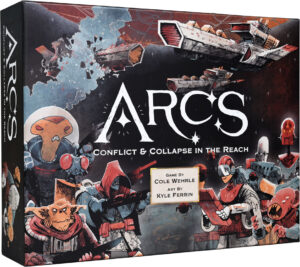 For a game that navigates the far reaches of space, the new entry from designer Cole Wehrle has certainly found a way to break through the dense modern hobby atmosphere. Since crowdfunding backers began receiving their copies in July 2024, there has been extensive coverage of the converging systems at play as well as discussion about who may enjoy it the most.
For a game that navigates the far reaches of space, the new entry from designer Cole Wehrle has certainly found a way to break through the dense modern hobby atmosphere. Since crowdfunding backers began receiving their copies in July 2024, there has been extensive coverage of the converging systems at play as well as discussion about who may enjoy it the most.
Arcs is hard to define. Its allure comes from the pedigree of the designer and the whimsical illustration by Kyle Ferrin. These two have worked with Leder Games to produce Root and Oath, and Arcs joins their four-lettered company. But what exactly is Arcs? There’s a constellation of mechanisms floating at zero gravity and we’re about to exit the safety of our airlock to piece these together.
Gameplay Overview:
To understand Arcs, we must first understand its frameworks. The central board features a circular arrangement of six inner gates that feature three separate external planet systems. Based on player count (Arcs plays from 2-to-4 players), a certain section is blocked off to tighten the board state. Players begin in predetermined sectors with ships and buildings (loyal pieces) seeded according to the setup card chosen.
Arcs is centered around card play. An opening hand features six cards and a game has a maximum of five chapters, though it can end earlier based on players reaching a pre-determined number of points. When all cards have been played, or all players have passed consecutively, a chapter ends.
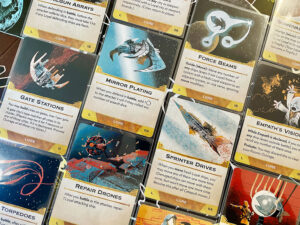
There are four suits of cards: Administration, Aggression, Construction, and Mobilization. When played, they provide certain action types and amounts. Each of these cards also features a value from two to six (one and seven included in a four-player game). Each card provides a combination of actions that can be taken in any order. For example, Mobilization cards allow access to both Move and Influence.
Main board actions – these require loyal pieces in space.
- Tax – Gain one resource from a loyal city or controlled rival city.
- Build – Build one new building (city or starport) or a new ship at a starport.
- Move – Move loyal ships to adjacent systems and/or use starport to catapult.
- Battle – Attack rival ships/buildings or raid other players for resources or court cards.
- Court card actions – Add cards to your tableau to enhance actions, boost ambition scoring, or trigger single-use events.
- Influence – Add an agent to a card in the court.
- Secure – Take one card from the court if have more agents than rivals.
The player with initiative leads. All consecutive players must consider their options from cards in hand. Below are the options available during a round:
- Lead – the played card determines the suit and provides all actions at its full pip count. For example, playing a Six of Construction allows a player to build or repair twice as it has two pips. The lead player can also declare an ambition, if one is available, to dictate scoring for the round.
- Follow – the played card can surpass, pivot, or copy the lead card. Surpass provides full pip actions if the suit is the same and the value is higher. Pivot provides one action only from an off-suit card. And copy happens by playing a card facedown and taking an action from the lead card’s suit.
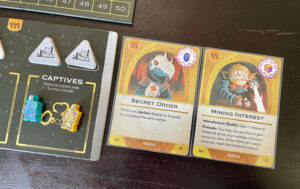
All card play is in service of board position, resource creation, and scoring via ambitions. When an ambition is declared, it provides players with a direction for chapter scoring. Ambitions can be declared up to three times, though chapters may have fewer and sometimes even a double or triple declaration into the same ambition. Ambitions correspond to the number value of each card ranging from two to six.
Scoring happens at the end of a chapter based on ambitions that were activated. These can be based on items gathered in your player tableau, including resources and card icons, captives (rival agents from court cards), and trophies (destroyed rival buildings and ships). Ambitions reset after each chapter and their scoring values increase as well.
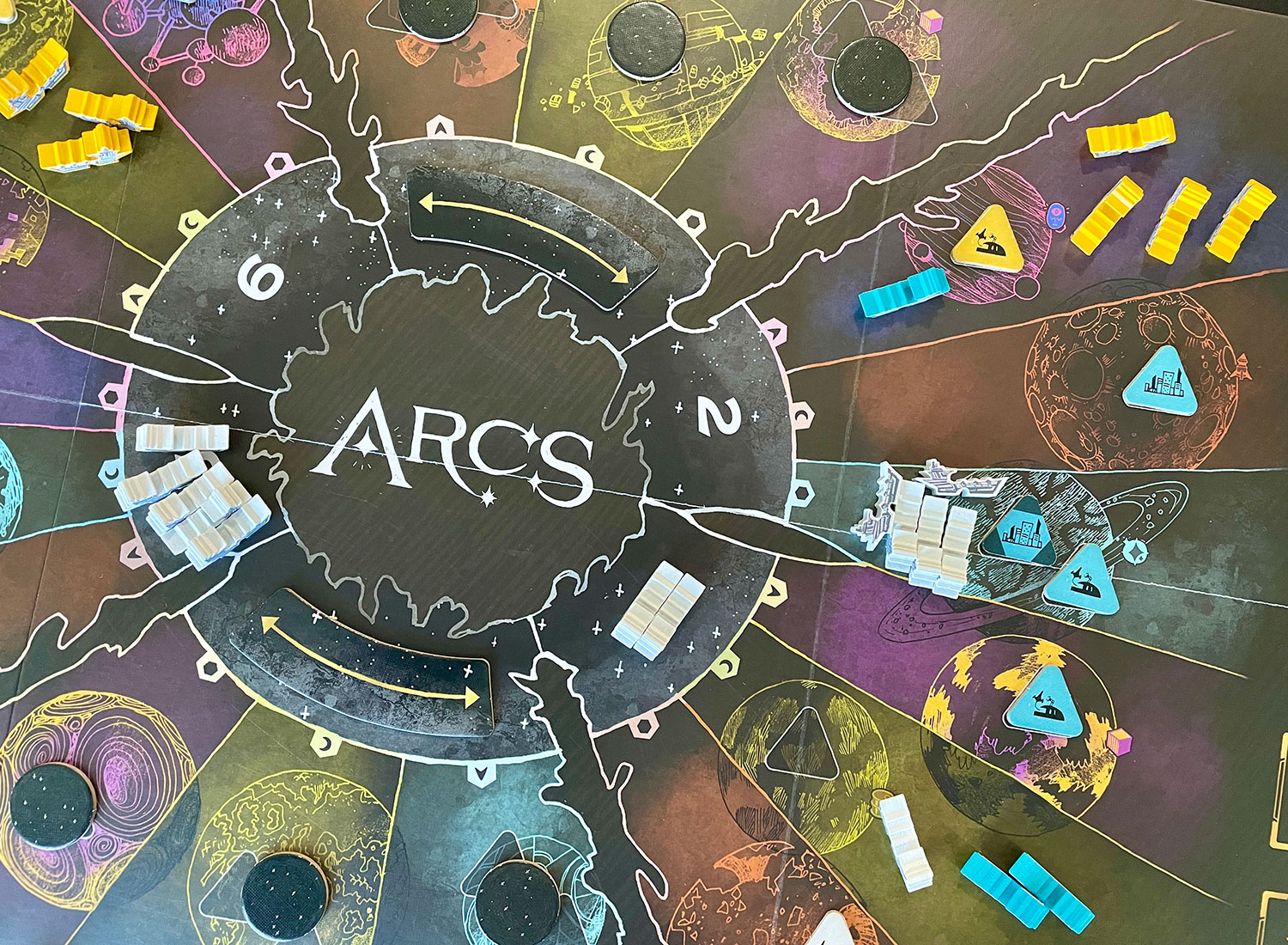
Game Experience:
As with many of Wehrle’s designs, there’s a lot to unpack. For Arcs, all it takes is a round or two to get the feel of the action selection system (as some are related to trick-taking). The rest of the systems take a little bit more time to settle into. There are additional layers of rules regarding control, ship and building damage, as well free actions called preludes and outrage. Layers that are expected and add depth.
I delight in many aspects of Arcs. The card action system is crunchy and limiting. It requires players to strategize but also be ready for tactical maneuvering at any moment. This is enhanced by chapter-specific scoring that is player-driven and unpredictable as it is activated by both initiative and card-type restrictions. The cards dealt to you are both a blessing and a curse.
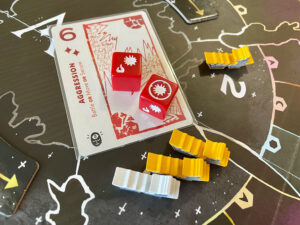
Cards are enhanced using resources via the Prelude. This system is what turns that hand of cards into more efficient action usage. Preludes allow players to spend resources (or activate cards) to take free actions prior to utilizing their card actions. Resource types dictate these effects, and this included system not only lessens restrictions, but it also makes the economy more dynamic. Preludes provide new combinations of actions and propulsion on turns when you’ve saved up.
But even preludes have a counter if players become too ambitious with their aggression. Destroying a rival city provokes outrage from those citizens. Doing this requires the removal of all resources and court cards with associated icons for the aggressor. It does have the upside of being able to secure a card in the court for free, but outrage can truly set players back. Yet another way to provide system limitations is to keep players in check.
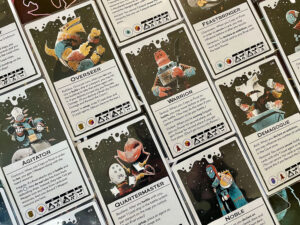
Challenges arise as players begin to branch out from their start positions and find friction in resource scarcity. Ambitions may turn a peaceful round into a free-for-all battle royale as ships and buildings take damage and become trophies for rivals. Attacking in Arcs is a joy. The aggressor chooses specific dice to roll—skirmish for small damage, assault for major damage as well as some loyal ship damage. There’s also the possibility for an intercept to happen, which allows defending ships to fire back for even more damage. But all determinations are made by the attacker which makes the entire combat quite smooth.
Arcs isn’t without its frustrations. Typically, these begin to lessen as players peel back the layers of interaction. But upon initial play, the card restrictions, the take-that, the run-away leader, the fight for initiative, and plenty of other traps can leave a sour taste. And while this may be one of the more accessible entries from the Wehrle/Ferrin duo, it requires time and effort to truly see it shine.
Part of the reason is the ruleset. There are some areas that are not as easy to internalize and some that feel like a full disconnect. Remembering small differences between how control works for taxing and building, as well as ransacking the court upon an outrage, have proven to be the worst offenders for our group. Then you have player tableaus that fill up with numerous rule-breaking abilities. The sprawl can sometimes become a counterpoint to intense focus on ambition scoring.
The base version of Arcs is an interesting puzzle with a 4X veneer and Pax-like scoring. But it is missing an element to truly make it shine. Thankfully, there’s the Leaders and Lore pack available to enhance the game. I would recommend this addition after a play or two as it provides asymmetric player powers (and constraints) as well as unique lore cards to add to your tableau. These greatly improve upon the base game as they provide direction for each session.
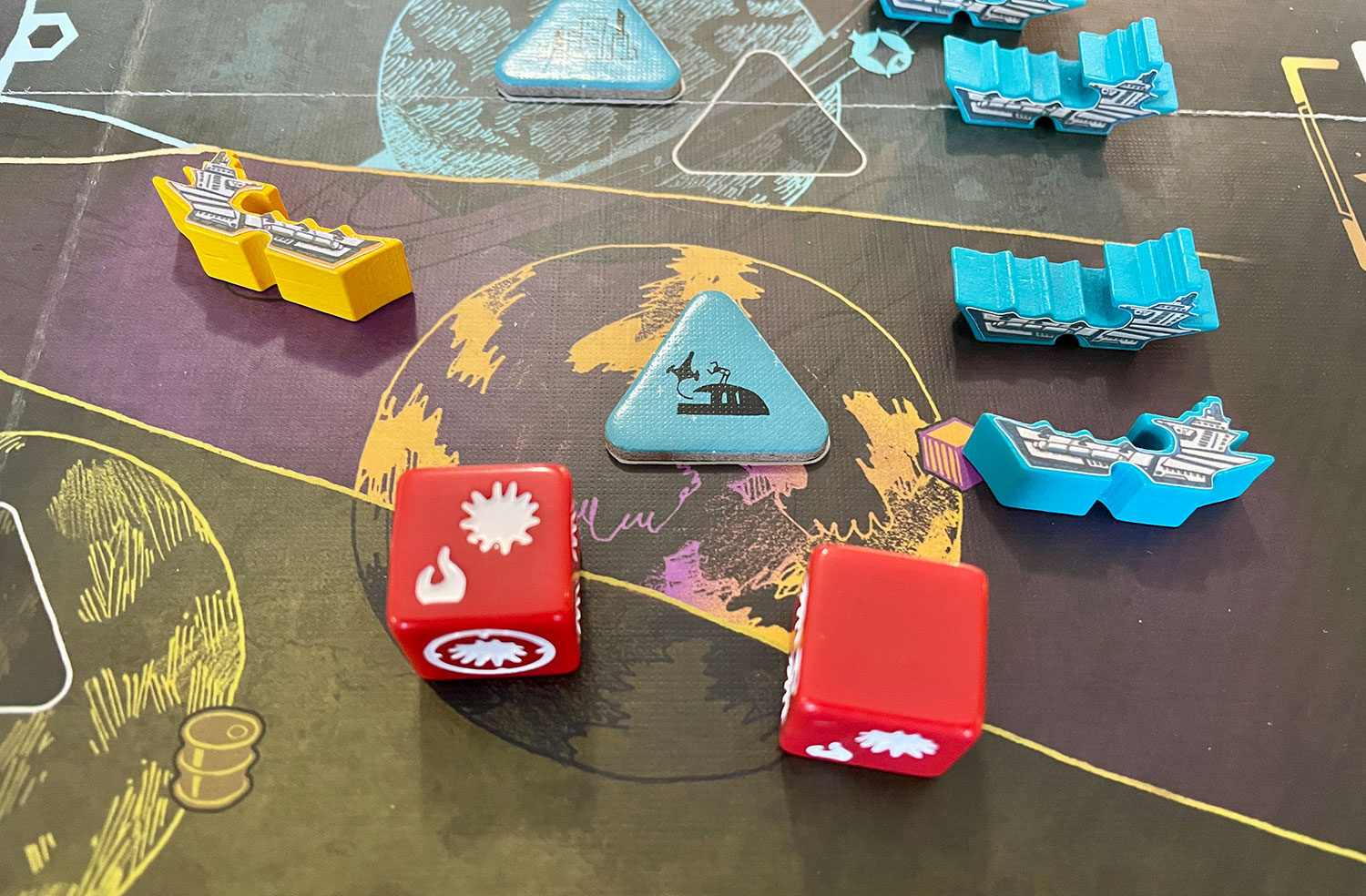
Final Thoughts:
I would never pass up a game of Arcs. Its systems mesh to create a design that synergizes well and provides plenty of push and pull along the way. I was initially concerned about the early buzz with this being touted as a heavily influenced trick-taking venture but was pleasantly surprised when it turned out to be more action selection focused (with very minor trick-taking influence).
Arcs doesn’t have the full asymmetry and density of Root, and that is great, but it also lacks the emergent narrative of Oath. It sits in a happy place in between and may be a perfect median for anyone not quite satisfied with either side of the earlier offerings. For my group, it doesn’t quite reach the heights of Oath. That said, the Arcs expansion The Blighted Reach promises an emergent narrative in a smaller package and has delivered impressive results after two full campaigns. This system seems destined for even more adventures to emerge in the future.
Final Score: 4.5 Stars – Reaches for the stars yet grounds itself as one of the best releases of the year.
 Hits:
Hits:
• Dynamic scoring system
• Constraining card choices
• Combat and raiding
• Limited economies
Misses:
• Base lacks emergent narrative
• Certain rule internalization
• Tableau rules sprawl
Source: Board Game Quest



